rims AUDI TT COUPE 2009 Owners Manual
[x] Cancel search | Manufacturer: AUDI, Model Year: 2009, Model line: TT COUPE, Model: AUDI TT COUPE 2009Pages: 316, PDF Size: 71.16 MB
Page 205 of 316
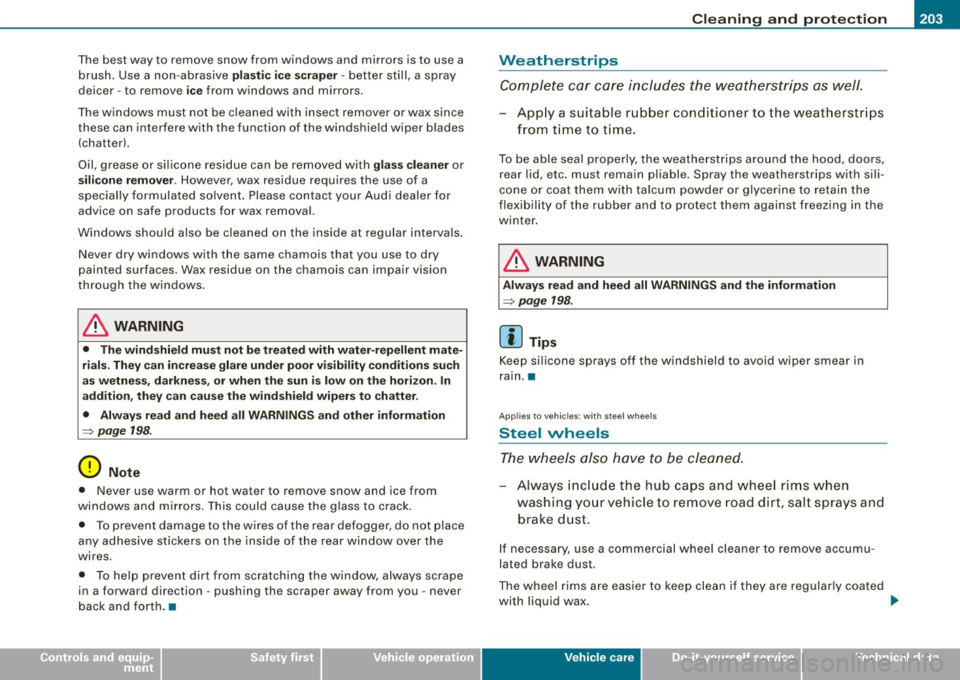
____________________________________________ _:C ::,: l~ e :,: a~ n:....:..:..: in~ g~ a~n .:.:d:!...! p~ r ~o~ te~ c~t ~io ~ n'....__lftlll
•
T he best way to remove snow from windows and mirrors is to use a
brush . Use a non -abrasive
pla stic ice scraper -better still, a spray
deicer -to remove
ice from w indows and mirrors .
The windows must not be cleaned with insect remover or wax since
these can inter fere with the function of the w inds hie ld w iper blades
(chatter).
Oil, grease o r sil icone residue can be removed with
glass cleaner or
s ilicone remover . However, wax residue requires the use of a
spec ially for mulated solvent . Please contact your Audi dealer for
advice on safe products for wax removal.
Windows should also be c leaned on the inside at regular intervals .
Never dry windows with the same chamois that you use to dry
painted surfaces . Wax residue on the chamois can impair vision
t hrough the windows.
& WARNING
• The windshield mu st not be treated with water -repellent mate
rials. They c an incre ase gl are under poor v isibility conditions such
a s wetne ss, darkne ss, or when the sun i s low on the hori zon. In
addition , they can cause the wind shield wipers to chatter .
• Alway s read and heed all WARNINGS and other information
~ page 198.
0 Note
• Never use warm or hot water to remove snow and ice from
windows a nd mirrors . This could cause the glass to crack.
• T o prevent damage to the wires of the rear defogger, do not place
any adhesive stickers on the inside of the rear window over the
wires.
• T o he lp prevent dirt from scratching the window, always scrape
in a forward direction -pushing the scraper away from you -never
back and forth. •
Weatherstrips
Complete car car e includes the we atherst rip s as well .
App ly a suitable rubbe r con ditioner to the weatherstr ips
f ro m time to tim e.
To be able sea l properly, the weatherstrips around the hood, doors,
rear lid, etc . must remain pliable. Spray the weatherstrips with sili
co ne or coat them w ith ta lcum powder or glycer ine to retain the
f lexibility of the rubber and to protect them against freezing in the
winte r.
& WARNING
Alway s read and heed all WARNINGS and the information
~ page 198.
[ i ] Tip s
Keep si licone sprays off the windshield to avoid wiper smear in
ra in .•
App lies to veh icles : with steel whee ls
Steel wheels
The wheels also h ave to be cleaned.
- Alw ays in clude the hu b caps and whee l rims when
washing yo ur vehi cle to remove road dir t, sal t sprays an d
b rake dust.
If necessary, use a commercial whee l cleaner to remove accumu
lated brake dust.
The wheel rims are easier to keep clean if they are reg ula rly coa ted
with l iquid wax. ..
Vehicle care I t •
Page 206 of 316
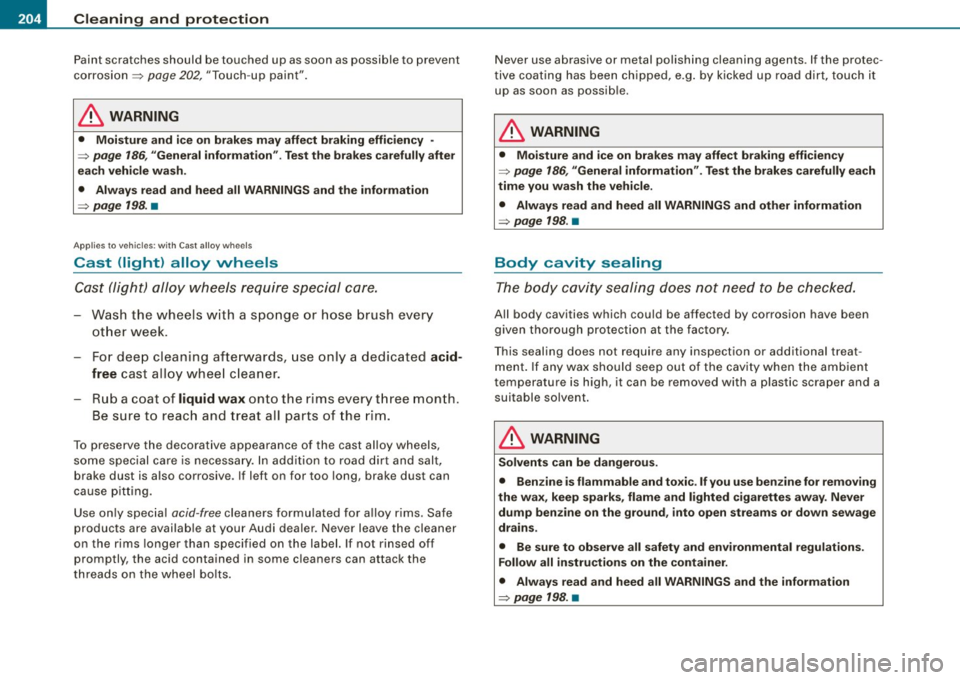
___ C_ le_ a _ n_i_n ~g _ a_ n_ d __ p_r _o _t _e _c_ t_ i_o _n ___________________________________________ _
Paint scratches should be touched up as soon as possible to prevent
corrosion => page 202, "Touch -up pain t" .
& WARNING
• Moi sture and i ce on brake s may affect braking efficiency -
=> page 186 , "Gene ral inform ation ". Te st the brakes caref ully a fter
e ac h veh icle was h.
• Alway s read and heed all W ARNING S and t he infor mation
=> page 1 98. •
App lies to vehi cles : w ith Cast a lloy whee ls
Cast (light) alloy wheels
Cast (light) alloy wheels require special care.
- Wash the wheels with a spo nge or hose brush every
o ther week .
- For deep cleaning afte rwards, use only a dedicated
a cid
free
cast alloy whee l cleaner.
- Rub a coat of
liquid wa x onto the rims every t hree month .
Be sure to reach and treat all parts of the rim.
To preserve the decorative appearance of the cast alloy wheels,
some special care is necessary. In addition to road dirt and salt, brake dust is also corrosive . If left on for too long, brake dust can
cause pitting.
Use on ly specia l acid -free cleaners formu lated for a lloy rims . Safe
products are availab le at your Audi dealer . Never leave the cleaner
on the rims longer than specified on the label. If not rinsed off
promptly, the acid contained in some c leaners can attack the
threads on the wheel bo lts . Never use abrasive or metal polishing cleaning agents
. If the protec
t ive coating has been chipped, e.g . by kicked up road dirt, touch it
up as soon as possib le.
& WARNING
• Moisture and ice on br akes m ay affect braki ng effici ency
=> page 1 86, "Gen eral inf or mation ". Te st the brake s carefully each
ti m e you w ash th e vehi cle .
• Always read and heed all WARNINGS and other informa tion
=> page 198 . •
Body cavity sealing
T he body cavity se aling does not need to be checked.
All body cavities which could be affected by corrosion have been
given thorough protection at the fac tory.
This sealing does not require any inspection or additional treat
ment . If any wax should seep out of the cavi ty when the amb ient
temperature is high, it can be removed with a p lastic scraper and a
suitable solvent .
& WARNING
Solvents can be dangerou s.
• Ben zin e is flamm able and to xic. If you use b en zi ne for re moving
the wax, keep spark s, flame and lighted cigarette s away . Never
dump ben zine on the ground , into open st ream s or do wn sewage
dr ain s.
• Be sure to ob serve all safet y and env ironment al regul atio ns .
Follow all in stru ction s on the c ont ainer .
• Alwa ys read and heed all WARNINGS and the infor mation
=> page 1 98 . •
Page 236 of 316
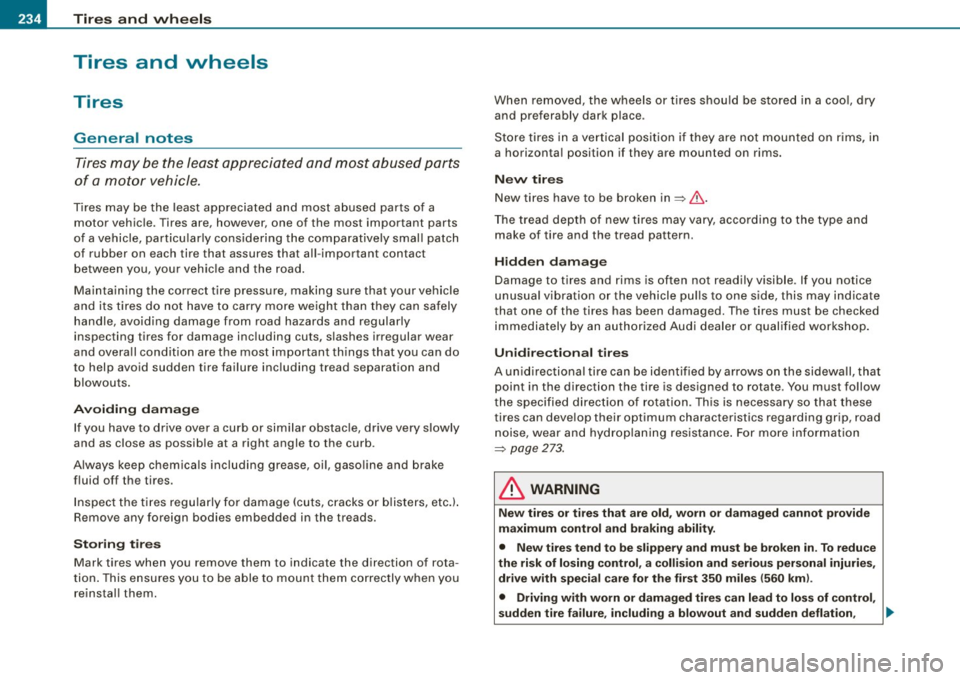
-~_T_ ir_e_ s_ a_ n_d _ w_ h_ e_e _l_s _________________________________________________ _
Tires and wheels
Tires
General notes
Tires may be the least appreciated and most abused parts
of a motor vehicle.
Tires may be the least appreciated and most abused parts of a
motor vehicle. Tires are, however, one of the most important parts
of a vehicle, particu larly considering the comparatively small patch
of rubber on each tire that assures that all -important contact
between you, your vehic le and the road.
Maintaining the correct tire pressure, making sure that your vehicle
and its tires do not have to carry more weight than they can safely
handle, avoiding damage from road hazards and regularly inspecting tires for damage inc luding cuts, s lashes irregular wear
and overa ll condition are the most important things that you can do
to help avoid sudden tire failure including tread separation and
blowouts.
A vo iding d am age
If you have to drive over a curb or similar obstac le, drive very slowly
and as close as possible at a right angle to the curb.
A lways keep chemica ls including grease, oi l, gaso line and brake
fluid off the tires.
Inspect the ti res regu larly for damage (cuts, cracks or b listers, etc.l .
Remove any foreign bodies embedded in the treads.
Storing tir es
Mark tires when you remove them to indicate the direction of rota
t ion. This ensures you to be able to mount them correctly when you
reinstal l them. When removed, the wheels or tires shou
ld be stored in a coo l, dry
and preferably dark place.
S tore tires in a vertical pos it ion if they a re not mounted on r ims, in
a horizonta l position if they are mounted on rims.
New tir es
New tires have to be broken in=>&.
The tread depth of new ti res may vary, according to the type and
make of tire and the tread pattern.
H idd en damage
Damage to tires and rims is often not readily visible. If you notice
unusual vibration or the vehicle pu lls to one s ide, this may indicate
that one of the tires has been damaged . The tires must be checked
immediately by an authorized Audi dealer or qualified workshop .
Unidire cti ona l t ires
A unidirectional tire can be identif ied by arrows on the sidewa ll, that
point in the direction the tire is designed to rotate . You must fo llow
t he specified directio n of rotation . This is necessary s o that these
tires can develop their optimum characteristics regarding grip, road noise, wear and hydrop laning resistance . For more information
=>
page 273.
& WARNING
New t ires o r ti re s th at a re old , worn or d am aged cann ot pro vid e
maximum cont rol and braking ability .
• New tires te nd to be slippery and mu st be bro ken in . To redu ce
the ri sk o f lo sin g co ntro l, a collis ion and serious per sonal injurie s,
dri ve w ith special care f or the fi rst 350 m ile s ( 560 km l.
• Driving w ith w orn or damaged tire s can lead to lo ss of control ,
sudd en tir e fa ilure , inc ludi ng a blowout a nd sudden defl atio n, ..,_
Page 242 of 316
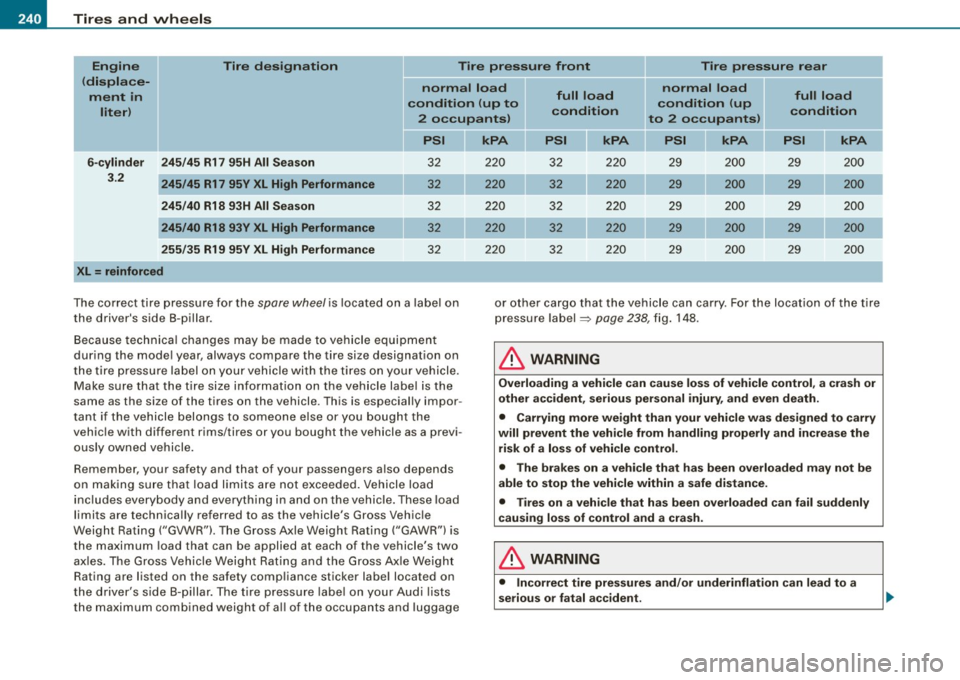
-~_T_ ir_e_ s_ a_ n_d _ w_ h_ e_e _l_s _________________________________________________ _
Engin e
(displa ce
ment in
lit er) Tire designation
Tir
e pressure front Tire pressure rear
normal load full load normal load
full load
condition (up to condition c
ondition (up
condition
2 o ccupants ) to 2 occupants)
6 -cylinder
3.2 245
/45 R1 7 95H All Season
245 /45 R17 95V XL High Performan ce
245 /40 R18 93H All Season
245 /40 R18 93V XL High Performan ce
255 /35 R19 95V XL High Performance
XL
= reinforced
PSI
32
32
32
32
32
The correct tire pressure for the spare wheel is located on a label on
the driver's side B-pillar .
Because technica l changes may be made to vehicle equip ment
during the mode l year, always compare the tire size designat ion on
the tire pressure la bel on y our vehicle with the tires on your vehicle.
Make sure tha t the t ire size information on the veh icle labe l is the
same as the size of the tires on the vehicle. Th is is especially impor
t ant if the vehicle belongs to someone e lse or you boug ht the
vehic le with different rims/tires or you bought the vehicle as a previ
ously owned vehicle.
Remember, your safety and that of your passengers a lso depends
on making su re tha t load limits a re not exceeded . Vehi cle loa d
inc ludes everybody and everything in and on the vehicle. These load
limits are technically referred to as the vehicle's Gross Vehicle
Weight Rating ("GVW R"). The Gross Axle Weight Rating ("GAWR") is
the maximum load that can be applied at each of the vehicle's two
ax les. The Gross Vehicle We ight Rat ing and the Gross Ax le Weig ht
Rating are listed on the safety comp liance sticker labe l located on
t he driver's side B- pillar. The tir e pressure labe l on y our Audi lists
the maximum combined weight of a ll of the occupants and luggage
kPA PSI kPA kPA kPA
220 32 220 29 2 00 29 200
220 32 220 29 200 29 200
220 3 2 220 29 2 00 29 200
220 32 220 29 2 00 29 200
220 3 2 220 29 200 29 200
or other ca rgo that the veh ic le can carry. For the location o f the t ire
pressure label::::;, page 238, fig. 148.
& WARNING
Overloading a vehi cle can cause loss of vehicle control , a crash or
other accident, serious personal injury, and even death .
• Carrying more weight th an your vehicle was de signed to carry
will prevent the vehicle from handling properly and increase the
risk of a loss of vehicle control.
• The brakes on a vehicle that has been overloaded may not be
able to stop the vehicle within a safe distance .
• Tires on a vehicle that has been overloaded c an fail suddenly
causing loss of control and a crash .
& WARNING
• Incorrect tire pressures and/or underinflation can lead to a
s erious o r fatal a ccident .
Page 248 of 316
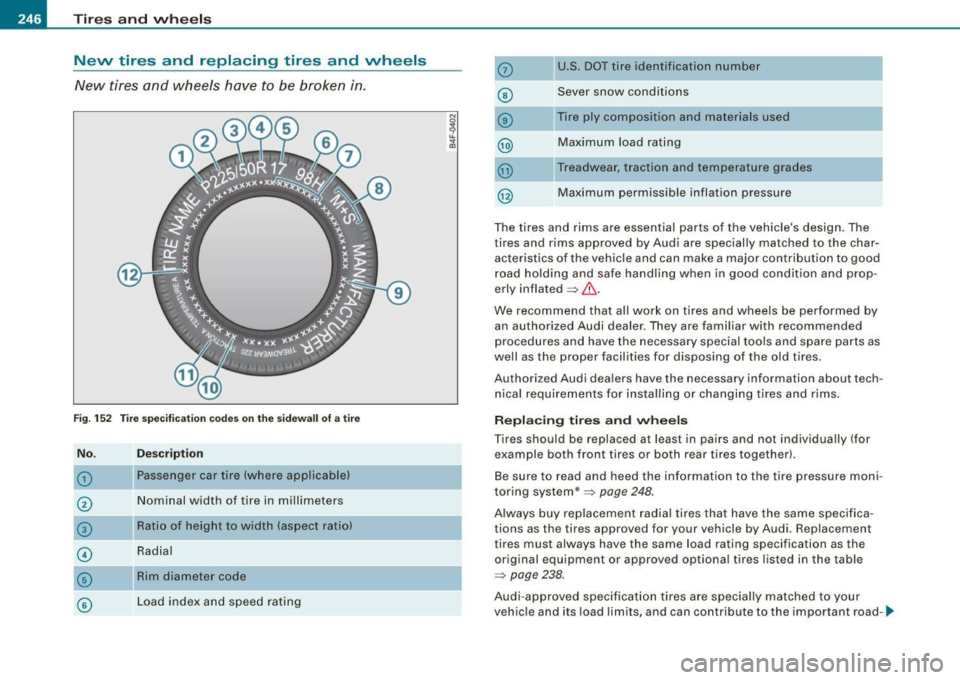
___ T_ i_ r_e _s_ a_ n_ d_ w_ h_ e_ e _ ls _________________________________________________ _
New tires and replacing tires and wheels
New tires and wheels have to be broken in.
F ig . 1 52 Tir e spec ifi cati on co des o n the sid ewa ll of a t ire
No . Desc ription
G)
®
©
©
©
©
Passenger car tire (where a pplicable)
Nominal width of tire in mi llimeters
Ratio of he ight to width (aspect ratio)
Radial
Rim diameter code
Load index and speed rating
0
©
©
@
@
U.S. DOT tire identification number
Sever snow conditions
Tire ply composition and materials used
Maximum load rating
Treadwear, traction and temperature grades
@ Maximum permissible inflation pressure
The tires and rims are essential parts of the vehicle's design. The
tires and rims approved by Audi are special ly matched to the char
acteristics of the vehicle and can make a major contribution to good
road ho lding and safe hand ling when in good cond ition and prop
erly inflated
~ & .
We recommend that all work on tires and wheels be performed by
an authorized Audi dealer . They are familiar with recommended
procedures and have the necessary special too ls and spare parts as
well as the proper facilities for disposing of the old tires.
Authorized Audi dea lers have the necessary information about tech
n ical requirements for insta lling or changing tires and rims .
Replacing tires and wheel s
Tires should be replaced at least in pairs and not individual ly (for
example both front tires or both rear tires together) .
Be sure to read and heed the information to the tire pressure moni
toring system *~ page
248 .
Always buy replacement radial tires tha t have the same specifica
tions as the tires approved for your vehicle by Audi . Replacement
tires must always have the same load rating specification as the
original equipment or approved optiona l tires listed in the table
~ page 238.
Audi -app roved specification tires are specially ma tched to your
vehic le and its load limits, and can contribute to the important road-~
Page 250 of 316

-~_T_ ir_e_ s_ a_ n_d _ w_ h_ e_e _l_s _________________________________________________ _
ture. For example, the numbers 2209 mean that the tire was
produced in the 22th week of 2009. The other numbers are
marketing codes that may or may not be used by the tire manufac
turer. This information is used to contact consumers if a tire defect
requires a recall.
Tire ply composition and materials used
The number of plies indicates the number of layers of rubber-coated
fabric in the tire. In general, the greater the number of plies, the
more weight a tire can support. Tire manufacturers also must indi
cate the materials in the tire, which include steel, nylon, polyester,
and others .
Maximum Load Rating
This number indicates the maximum load in kilograms and pounds
that can be carried by the tire.
Tire quality grading for treadwear, traction, and
temperature resistance
Tread wear, traction and temperature grades => page 249.
Maximum Permissible Inflation Pressure
This number is the greatest amount of air pressure that should ever
be put in the tire under normal driving conditions.
Replacing tires or rims on vehicles equipped with tire
pressure monitoring system*
The wheels on your vehicle are equipped with a sensor which
constantly monitors the air pressure inside the tire, and then trans
mits this information to the tire pressure monitoring system *. If you
are going to replace the wheel rims on your vehicle, make sure the
new rims also have these sensors . The sensors must be compatible
with the tire pressure monitoring system * on your vehicle.
If the sensors are to be installed on different rims , the seal, washer ,
and valve cap for each sensor must be replaced.
If you install rims, which do not have the sensors, or have sensors
which are not compatible, then the tire pressure monitoring system* will not work properly.
In this case, the tire pressure moni
toring system * would not be able to monitor the tire pressure or
warn you if it is necessary .
• The battery inside of the tire pressure sensor has a limited
service life.
• Always drive with the valve stem caps securely mounted. We
recommend using factory installed valve stem caps. Ask your autho
rized Audi dealer to replace lost valve stem caps.
The installation of replacement tires with steel cord body plies in
the tire sidewall may cause malfunction of the tire pressure moni
toring system*, and is not recommended (cord material information
in molded on the tire sidewall) .
Always check your tire pressure monitoring system* indicator after
replacing one or more tires on your vehicle. If the tire pressure
monitoring system* indicator flashes, or is on, your system is not
working properly. Your replacement tire might be incompatible with
your tire pressure monitoring sys tem* , or some component o f the
tire pressure monitoring system* may be damaged.
& WARNING
• Using incorrect or unmatched tires and/ or wheels or improper
tire and wheel combinations can lead to loss of control, collision
and serious personal injury.
• Always use tires, rims and wheel bolts that meet the specifica
tions of original factory-installed tires or other combinations that
have been specifically approved by the vehicle manufacturer .
• Tires age even if they are not being used and can fail suddenly,
especially at high speeds. Tires that are more than 6 years old can
only be used in an emergency and then with special care and at
lower speeds.
• Never mount used tires on your vehicle if you are not sure of
their "previous history." Old used tires may have been damaged
even though the damage cannot be seen that can lead to sudden
tire failure and loss of vehicle control. .,_
Page 251 of 316

________________________________________________ T.:......... ir--=e :....:s:......: a--=n..:.. d.::..:..... w..:....:.... h :....:..:e:....:e:..: 1-=s :...__IJlll
•
& W ARNING (continu ed )
• All four wheels must be fitted with radial tire s of the same type ,
s ize (rolling cir cumference ) and the same tread pattern . Driv ing
with different t ires redu ces vehicle h andling and can lead to a loss
of contro l.
• If the spare tire is not the same a s the tires that are mounted
on the vehicle -for e xample with winter tires -only use the spare
tire for a short period of time and dr ive with extra c are . Refit the
norm al road wheel as soon as safely possible .
• Never drive faster than the maximum speed for which the tires
on your vehicle are rated because tires that are driven faster than
their rated speed can fail suddenly .
• Overloading tires cause heat build-up , sudden tire failure ,
including a blowout and sudden deflation and loss of control.
• Temperature grades apply to t ires that are properly inflated and
not over or underinflated .
• For te chnical reasons it is not always possible to use wheels
from other vehicles -in some cases not even wheels from the
same vehicle model.
• If you install wheel trim discs on the vehicle wheels , make sure
that the air flow to the brakes is not blo cked . Redu ced airflow to
the brakes can them to overheat , in creasing stopp ing distances
and causing a collision .
• Run flat tires may only be u sed on vehicle s that were equipped
with them at the fa ctory . The vehicle must have a chassis de signed
for run flat tires and a factory -installed tire pressure monitoring
system* that indicates a loss of tire pressure. In correct use of run
flat tires can lead to vehicle damage or accidents . Check w ith an
autho riz ed Audi dealer or tire specialist to see if your vehicle can
be equipped with run flat tires . If run flat tires are used, they must
be installed on all four wheel s. Mixing tire types is not permitted .
0 Note
• For techn ica l reaso ns, it is not genera lly poss ib le to use t he
whee l rims from other vehicles. This can hold true fo r wheels of the
same vehicle type .
• I f the s pare t ire is d ifferent from the tires that you have mounted
on your vehicle ( fo r example win te r ti res or wide p rofile tires), then
use the spa re tire for a short period of time on ly and drive with extra
care. Replace t he flat tir e w ith the tire matching the others o n your
vehic le as soon as possib le.
• If you s hould put different whee ls a nd tires on your ve hic le (e.g.
winter wheels and tires), you must be certain that the whee ls and
t ires are co mpa tibl e w ith the tire pressure mon itor in g syste m*.
Otherwise the system w ill reg ister a malfunction and a fault
m essage w ill be d isplayed . For more info rma tion, co ntact your Aud i
dea ler.
0 Note
• When installing new tires, be careful not to damage the va lves or
tire p ressu re m on itoring system senso rs* .
• N ever drive without the valve stem cap. The valves could get
da mage d.
• I f the sensors must be replaced, then the valve must also be
r eplaced at the same time.
ci> For the sake of the environment
Dis p ose o f old tir es in acco rdance with the local requ ireme nts .•
Uniform tire quality grading
• Tread wear
• Traction AA A B C
• Temperature A B C
Vehicle care
I t •
Page 254 of 316

-Tires and wheels
P'tr:1-------------------
Remove wheel center covers and trim discs befor e putting snow
ch ain s on y our ve hic le ~
(D. For sa fe ty rea sons c over ca ps m us t
th en be fitted over the wheel bo lts. These ar e avai lable from autho
rized Audi deale rs.
& WARNING
Using the wrong snow chains for your vehicle or installing them
incorrectly can increase the risk of loss of control leading to
serious personal injury.
• Snow chains are available in different sizes . Always make sure
to follow the instructions provided by the snow chain manufac
turer .
• When driving with snow chains never drive faster than the
speed permitted for your spec ific snow chains.
• Always observe local regulations.
0 Note
• Remove s now c hains befo re driv ing on roads no t cove re d w it h
snow to avoid damag ing tires and wearing the snow chains down
un nece ss aril y.
• Snow chains, whic h come into direct contact with the wheel rim,
can scratch or da mag e it. There fo re , m ake sure t hat th e s now ch ai ns
a re s uitably covered. Check the position of the snow chains after
dr ivin g a few yar ds a nd correct if ne cessary . Fo ll ow the in struc tions
from t he snow cha in manufacturer when do ing so.
[ i ] Tips
Where snow chains are mandatory on certain roads, this normal ly
a ls o ap plies to vehicle s w ith All W hee l Dr ive.•
Wheel bolts
W heel bo lts mu st a lways be ti ghte ned to t he corr ect
t o rq ue .
The design of wheel bolts is matched to the facto ry instal led rims . If
diff eren t rim s are fitt ed, t he cor rect w heel bol ts with the r ig ht le ngth
and correctly shaped bolt heads must be used. This ensures that
w hee ls a re fitted securely and t hat t he brake sys te m funct io ns
correctly.
In cer tain ci rc u ms tances, yo u may no t use whee l b olt s fro m a
different vehicle -even if it is the same model~
page 295.
& WARNING
Improperly tightened or maintained wheel bolts can become loose
causing loss of control, a collision and serious personal injury .
• Always keep the wheel bolts and the threads in the wheel hubs
clean so the wheel bolts can turn easily and be properly tightened .
• Never grease or oil the wheel bolts and the threads in the wheel
hubs. They can become loose while driving if greased or oiled,
even if tightened to the specified torque.
• Only use wheel bolts that belong to the rim be ing installed.
• Never use different wheels bolts on your vehicle.
• Always maintain the correct tightening torque for the wheel
bolts to reduce the risk of a wheel loss .
If the tightening torque of
the wheel bolts is too low , they can loosen and come out when the
vehicle is moving. If the tightening torque is too high, the wheel
bolts and threads can be damaged and the wheel can become
loose .
0 Note
The specified torq ue for the wheel bolts is 9 0 ft lb (120 Nm) with a
t o lerance of± 7,4 f t lb (± 10 N m). To rque w hee l bo lt s d ia g ona lly .
After chang ing a wheel, the torque must be checked as soon as
~
Page 260 of 316

-~_T_ ir_e_ s_ a_ n_d _ w_ h_ e_e _l_s _________________________________________________ _
• Transmitters with the same frequency , such as radio head
phones in the vehic le or radio equipment, can cause a temporary
disruption of the system through excessive electromagnetic fields .
• Elimina te the interference if possible/if you can and then
proceed as follows : Turn off the engine for 20 minutes . T hen drive
another
1 0 min. If the warning light comes on aga in, you should
contact your authorized Audi dealer immediately to have the problem corrected .
• Do not use commercially avai lable tire sea lants. Otherwise, the
e lectrical componen ts of the tire pressure monitoring system* wil l
no longer work properly and the sensor for the tire pressure moni
toring system * will have to be replaced by a qualified workshop .•
Run-flat tires
Ap plies to ve hic les : w it h R un -f la t tires
Introduction
Run-flat tires help keep you moving if a tire goes flat.
Re inforced sidewalls give the tires run -flat capability if t ire pressure
is lost .
We recommend that run -flat tires only be mounted on vehicles that
were origina lly equipped with these special tires at the factory and
have a Tire Pressure Monitoring System.
Run-flat tire s can be identified by the letter s "RSC" on the tire side
wa ll.
If you do change the tires on you r vehicle from normal to run -flat
tires , you must buy the special rims required for run -flat tires, and
the Tire Pressure Mon itoring System must be reprogrammed by an
authorized Audi dea ler or other qual ified workshop.
What do run -fl at tires do ?
These specia l tires have run-flat capabilities that help keep you
moving if a tire loses pressure and goes flat. Under favorab le condi -tions tires can be driven
a
t lea st 30 mile s (50 km ), but you must not
drive
fa ster than 50 mph (80 km/h )=> page 259, "Driving with run
flat tires".
The Tire Pressure Monitoring System constant ly checks the air pres
sure in the tires. If the run-flat system is active (shown in the center
display), you must inspect the affected t ire or t ires and then decide
whether to cont inue dr iving. Be sure to fol low these tips
=> page 259, "Driving with run -flat tir es" .
When it is n ot po ssible to c ontinue dri ving, ev en with
run-flat tir es?
• I f the Electronic Stabi lization Program (ESP) is not work ing o r
keeps coming on.
• I f the Tire Pressure Monitoring System does not work.
• I f the tire has been severely damaged, in a crash, for example .
T he t read can separate from a damaged tire as the wheel turns , and
hit parts of the vehicle, such as the fuel tank filler neck, fuel lines or
brake lines.
• Do not con tin ue d riving if severe vibra tion occurs or if the tire
starts to smoke because the tire is running hot.
• Do not conti nue drivi ng if da mage to the tire, such as cracks in
the sidewal l, appears .
& WARNING
Improper use of run -fl at tires can cause ve hic le da mage th at can
le ad to los s of vehicle control , a crash and seriou s personal injury .
• Run-flat t ires can only be used w ith spe cial rims .
• Run -fl at tires must always be monitored with a properly
programmed Tire Pre ssure Monitoring Sy stem.
• Alway s inspect a tire that ha s lo st air to make sure it i s safe to
drive with the tire in the run -flat mode .
• Never dr ive with run -fl at tire s th at have been dam aged in a
colli sion.
Page 261 of 316
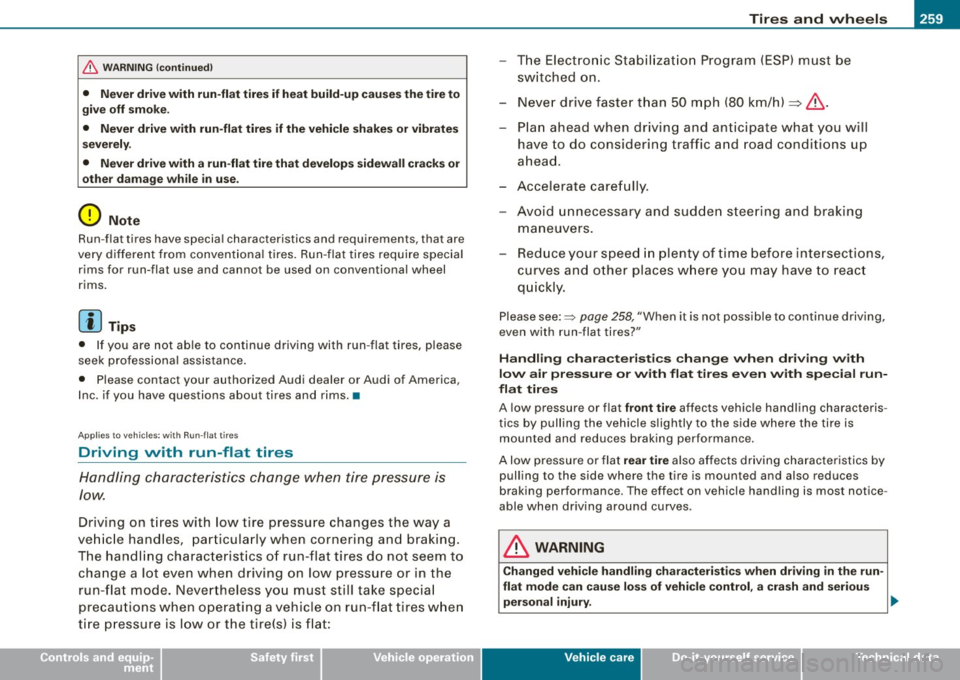
________________________________________________ T_ ir_e _s_ a_n_ d_ w_ h _e_e_ l_s __ lfll
•
& WARNING (continued)
• Never drive with run-flat tires if heat build-up causes the tire to
give off smoke .
• Never drive with run-flat tires if the vehicle shakes or vibrates
severely.
• Never drive with a run-flat tire that develops sidewall cracks or
other damage while in use .
0 Note
Run-flat tires have specia l characteristics and requirements, that are
very different from conventional tires. Run-flat tires require special
rims for run-flat use and cannot be used on conventional wheel
rims.
[ i] Tips
• I f you are not able to continue driving with run -flat tires, please
seek professional assistance.
• Please contact your authorized Audi dealer or Audi of America,
Inc . if you have questions about tires and rims. •
Applies to vehic les: with Run-flat t ires
Driving with run-flat tires
Handling characteristics change when tire pressure is
low.
Driving on tires with low tire pressure changes the way a
vehicle handles, particularly when cornering and braking.
The handling characteristics of run-flat tires do not seem to
change a lot even when driving on low pressure or in the
run-flat mode. Nevertheless you must still take special
precautions when operating a vehicle on run-flat tires when
tire pressure is low or the tire(s) is flat: The
Electronic Stabilization Program (ESP) must be
switched on.
- Never drive faster than 50 mph (80 km/h)~
&-
Plan ahead when driving and anticipate what you will
have to do considering traffic and road conditions up
ahead.
- Accelerate carefully.
- Avoid unnecessary and sudden steering and braking
maneuvers.
Reduce your speed in plenty of time before intersections,
curves and other places where you may have to react
quickly.
Please see:=> page 258, "When it is not possible to continue driving,
even with run -flat tires?"
Handling characteristics change when driving with
low air pressure or with flat tires even with special run
flat tires
A low pressure or flat front tire affects vehicle handling characteris
tics by pulling the vehicle slightly to the side where the tire is
mounted and reduces braking performance.
A low pressure or flat rear tire also affects driving characteristics by
pulling to the side where the tire is mounted and also reduces
braking performance. The effect on vehicle handling is most notice
able when driving around curves.
& WARNING
Changed vehicle handling characteristics when driving in the run
flat mode can cause loss of vehicle control, a crash and serious personal injury. .,,,
Vehicle care
I t •